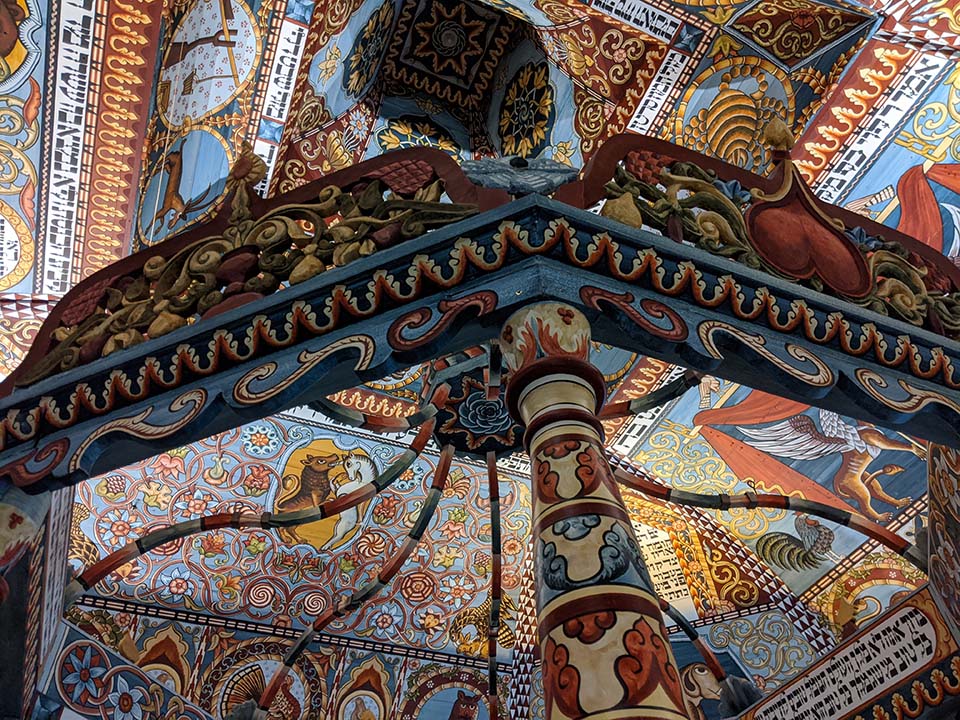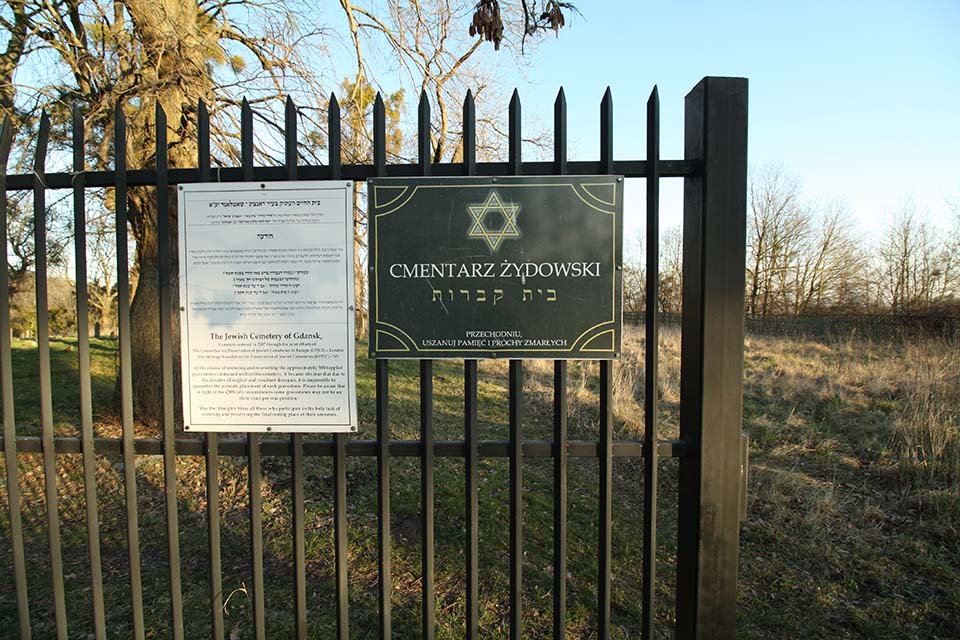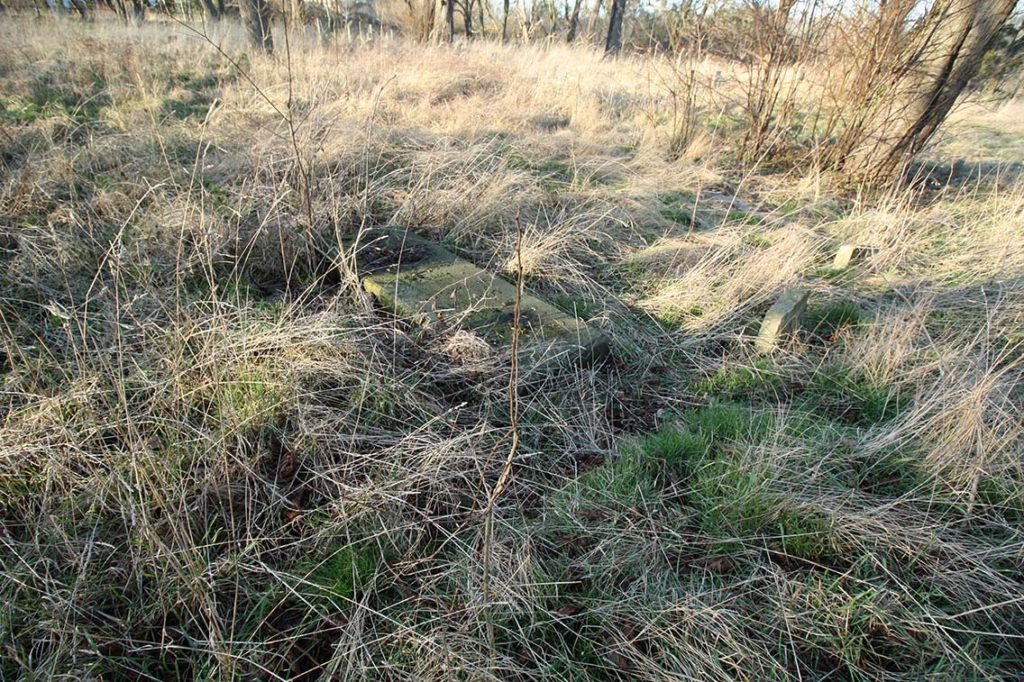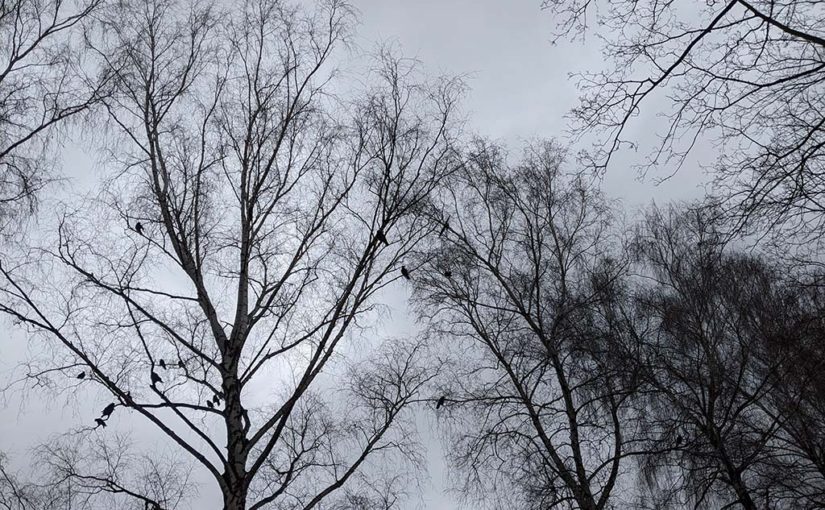Concentration camps, cemeteries, museums and synagogues, with reflections on monuments, tradition and humanity.
This article is a collection of notes and photos from my exploration of Jewish culture and history in Poland over the past couple months.
I consider myself Jewish, while at the same time, I’m not much of a believer and am not all that religious. For me, at this point in time, being Jewish is about tradition, history, family, community and acceptance. These experiences strengthened and helped me better appreciate those Jewish aspects of my identity.
On the other hand, I don’t think you have to be Jewish to enjoy this article, or learn from these experiences. There’s a lot here, and I broke it out into the following sections, which you can jump to using the links provided.
- Auschwitz-Birkenau concentration camp
- POLIN Museum of the History of the Polish Jews
- The Nożyk Synagogue in Warsaw
- Jewish cemeteries in the Tricity
- The New Synagogue of Gdansk, featuring an interview with the synagogue’s Vice President, Micahł Rucki
There’s certainly been a ton written on many of the topics above. However, seeing the sights in person, and talking to people who are carrying on the traditions, and in a way living and building on the history, today is a different and more powerful perspective, which I hope to capture and share in the sections below.
Auschwitz-Birkenau

When I visited Dachau a couple years ago, I described it as “a powerful, gut-wrenching, chilling experience.”
My recent visit to Auschwitz-Birkenau was the same, only more so.
It was like taking a walking tour of a past nightmare.
As tough as these visits are, I think they’re essential, for the same reason I read books like The Rape of Nanking, The Gulag Archipelago and Ordinary Men: it’s healthy to read, see, hear, touch, recognize and remember the grim, evil side of humanity that lives in every reader, every visitor, every tourist, every one of us.
When I toured the concentration and extermination camps, it had been raining on and off for the past day. The muddy ground gathered small puddles of water on the pathways and the bricks. The puddles rippled softly in the slight wind, like the ground was trembling. Still terrified and shivering after all these years.
At Birkenau we walked down the same path that prisoners walked toward the gas chambers after being selected for death.
Everyone was quiet in our group, and our tour guide did a great job of setting a respectful and somber tone.
All I could hear was the wind blowing and the sound of my shoes hitting the damp muddy and rocky path. I saw my shoes falling to the ground in front of me, under my nose, one after the other, making quiet impacts in the quiet wind.
I felt the rocks and bricks under the soles of my feet, sliding in the mud, stepping in puddles. I imagined the hundreds of thousands of people who walked down that same path under terrifying circumstances.
I pictured myself in their situation: confused, terrified, rushing from one place to another, wondering what to pack for the trip to the labor camp, making the best of the situation, trying to be strong for my family and friends.
2,000 people in 15 minutes
That’s how fast they were killing people at capacity with the gas chambers in Auschwitz, using the gas Zyklon B. They would make prisoners take off their clothes among the trees nearby and then rush naked down a set of steps into a lower bunker-like room where they’d be packed to the brim, to maximize efficiency. The gas also killed quicker in hotter environments so the crowded warm bodies helped to that effect.
The bottleneck in the process was not the killing, but rather, the burning of the dead bodies afterwards. Thus, they’d burn as many of the bodies as possible in the crematorium ovens, and then take the remainder outside to be burned in an open-air pit. The ashes of the bodies were scattered all over the camp grounds.
In this sense, the tour also gave me a better appreciation for how much everything in this nightmare massacre system was about efficiencies, operations, logistics, optimizing constrained resources.
For example, once the camp was full — and operating at its capacity — they would have people on the trains unload and go directly to the staging area for the gas chambers. This was especially the case for Hungarian Jews: when they arrived they just didn’t have space.
Exhibit showing supports for the disabled
We saw piles of old prosthetic limbs, crutches, braces and wheelchairs gathered from prisoners after they were killed. These prisoners were processed for killing quickly in the “selection” when they arrived. The guards would determine within a few seconds whether a captive was fit to work. If yes, the prisoner would go in the slave line. If no, they’d go in the slaughter line. Pregnant women, children, elderly, infirm and disabled would go to the slaughter line.
Exhibit showing hair
We saw mountains of blonde and brown hair that was cut from the heads of women’s corpses after they’d been killed in the gas chambers. The hair was used to make textiles, fabrics, socks, blankets and other products.
Exhibit showing shoes
We saw mounds of shoes that were taken from prisoners when they arrived at the camp. They looked so nice and normal. Like dress shoes worn to work, sneakers worn to play, and fancy shoes worn to go out to a nice dinner or party. Shoes everyone would have worn back then, I imagine.
Exhibits of photos
The exhibits on the tour do an excellent job in their use of selected powerful images. There aren’t so many to look at that it’s overwhelming or diluting. Instead, they feature a few at a time, presented at a large scale, that put you there.
Photos of families with kids walking dow the path to the gas chambers. A little boy holds hands with two younger kids — whom I imagine to be his brother and sister — as they walk down the path. I imagine the women behind him are his mother and grandmother. The little boy seems scared too, but he’s trying to be strong for his mom, brother and sister.
Mugshots of camp prisoners lined one of the hallways we walked through. Some of them seemed to be smiling with their eyes, somehow.
Secret photos — the only discovered surviving photos that show the gas chamber operations in action — taken by the prisoners who were tasked with burning the bodies from the gas chambers. These workers were called the Sonderkommandos, and they were the only prisoners who knew about the mass extermination operations at the camp. As such, these prisoners were usually short lived, and cycled out quickly, because the Nazis did not want word to spread to other prisoners in the camp.
Paintings
In the barracks where they used to house children in Birkenau, we saw two original paintings that the adult prisoners made for the kids. One showed kids playing with toys, and the other showed a child with a backpack and hat walking cheerfully to school. These were originals and they’re still up in the buildings today.
Gas chamber and crematorium
We walked through one of the earlier and smaller gas chambers, which was built before they constructed the high volume ones toward the later years of the camp. I could feel the density in the air. Running my hand across the bricks on the walls, chills in every which way.
Block 11
We saw the prisoner cells and basement, where they dealt with prisoners who acted out of order. The standing cells, with no windows and small vents, in which they’d stuff four prisoners for days on end. Many would suffocate in the process. Other prisoners would be sentenced to death by starvation for trying to escape the camp.
In the same area we saw the death wall that was destroyed and is now rebuilt as a memorial. That’s where they’d take people after they were convicted, to be shot in front of a wall in the courtyard. The trials would only last for a few seconds, defendants would be always be found guilty.
International monument

“For ever let this place be a cry of despair and a warning to humanity, where the Nazis murdered about one and a half million men, women, and children, mainly Jews from various countries of Europe.
Auschwitz – Birkenau 1940 – 1945″
POLIN Museum of the History of Polish Jews

This was a fascinating museum in Warsaw that tracks — in impressive detail — the history of Jews in Poland.
I visited the museum when I stopped in Warsaw for a few hours on my way south to tour Auschwitz-Birkenau concentration camp. There are three things that stuck with me:
First, the cool mythology of the museum’s name. From the museum brochure: “According to the legend, Jews fleeing persecution came east. When they arrived in a forest, they heard the word Polin, which sounded like “Rest here” in Hebrew. They knew then that this was the place to settle. Polin is the Hebrew word for Poland and the inspiration for the name of POLIN Museum of the History of Polish Jews”
Second, this visit was yet another crystallized reminder of, and a better appreciation for, how quickly things can change. Poland used to have the largest population of Jews in the world. In less than a decade, 3 million Polish Jews — 90 percent of Poland’s Jewish population — were killed in The Holocaust. Now it ranks 40th on Wikipedia’s list of Jewish population by country, with only about 10,000 to 20,000 remaining.

Third, the pluralism of monuments. In this case, the Monument to the Ghetto Heroes, which stands outside the POLIN museum’s entrance commemorating the Warsaw Ghetto Uprising. According to the brochure, the Monument to the Ghetto Heroes was unveiled on the rubble of the Warsaw ghetto in 1948, and it became an icon of the fight for freedom and dignity in Poland and abroad. In 1983 it was used to serve a different purpose, from an exhibit in the POLIN museum:
To ingratiate themselves with the West, the martial law authorities played the ‘Jewish card’. In 1983they organised an official cermony to commemorate the 40th anniversary of the Warsaw ghetto uprising. The Warsaw Nożyk Synagogue was refurbished and reopened. The opposition including Jewish members, boycotted the ceremony. Mark Edelman declared: ‘The commemoration of our anniversary here, at a time when the whole of society is enslaved and humiliated, when words and deeds have been utterly falsified, constitutes a betrayal of our struggle … I will not be taking part’. An unofficial demonstration identified the Solidarity movement with the ghetto fighters’ battle for freedom and dignity.

The Nożyk Synagogue in Warsaw

Text from a plaque in the entry way to the Nożyk Synagogue in Warsaw:
This is indeed a remnant rescued from the flames.
…Zachariah 3:2
This synagogue miraculously stands today…the only synagogue in all of Warsaw to survive the flames of World War II. It was desecrated during the war, rebuilt almost forty years later and renovated once again also through the generous help of the Ronald S. Lauder Foundation of New York.
Jewish cemeteries in the Tricity
The only two Jewish cemeteries in the region are both rundown and sad after decades of demolition, vandalism and neglect. They both sat in stark contrast next to Catholic cemeteries that appear well maintained. This makes sense when you consider that there are so few, if any, survivors or descendants from those buried in the Jewish cemeteries. Mr. Rucki (who you’ll meet below) and the folks at the New Synagogue in Gdańsk are working to restore these places.
The Jewish Cemetery of Gdańsk
This is a fairly large cemetery that generally looks like an overgrown city park or field. The surviving headstones are up on a hill, and many of them are damaged, overgrown and buried themselves.



Sopot’s Jewish Cemetery
The Jewish cemetery in Sopot is much smaller than the one in Gdańsk, and also much more decrepit. According to In Your Pocket, the graves date from 1922 to 1936, and the site also has a memorial to Jewish soldiers, which you can see in the last image in the set below.




References, further reading on Jewish Gdańsk
The New Synagogue in Gdańsk
I visited the New Synagogue in Gdańsk a few times: once to attend shabbat services on a Friday night; later to visit their small exhibit on the history of Judaism in Gdańsk; and finally to sit down and chat with Michał Rucki, Vice President of the synagogue.
This section pulls from all three of my visits, along with the articles I link to in the resources section above. I also paraphrased and edited for clarity the notes from my chat with Mr. Rucki.
Given the size of the Tricity metro area of Poland, which covers the cities of Gdańsk, Gdynia and Spot, I was surprised to learn that this is the only active, and the only surviving, synagogue in the area.
“Jews in America — not only in America — don’t understand exactly the huge tragedy in Poland with Polish Jews,” Mr. Rucki said. “It’s a very special place. When we started 30 years ago after the collapse, we started from zero. Rabbis came [to Poland] from America and started building slowly. They were starting from zero. And slowly step by step, now we exist like other communities.”

Mr. Rucki has been working at the synagogue since the building was reopened about 30 years ago. He was part of a small group of Jews who stayed in the area and remember times before World War II. According to Mr. Ruki, 90 percent of Jews from Gdańsk escaped before the war, many to South America.
“Before the war every city was a jewish community, now there, we are a small group of pre-war communities,” Mr. Rucki said.
In addition to its role as a place of worship, the New Synagogue in Gdańsk also serves as the Jewish Community Center for the small number of Jews in the area. There are 85 active members, according to Mr. Rucki, with about 120 members in total if you include all family members.
Mr. Rucki is part of a small three-person team that runs all the operations at the synagogue, spanning religion, tradition and culture. This work falls into two main categories: 1) services for members such as worship, education and welfare for the elderly; and 2) collaboration with the area’s non-Jewish society, which includes activities, events and partnerships with the city’s theaters, musicians and artists.
Technically it’s an orthodox Jewish synagogue; however they welcome everyone, and they are working hard to be part of the broader community in the area — they don’t want to isolate themselves.
“We have many friends [including] non-Jewish who cooperate with us,” Mr. Rucki said. “We are part of the society in Gdańsk. We don’t need a small ghetto for a small group of people. We have an idea to go outside. This is our role for many years.”
One of their biggest challenges is that many of their younger members are leaving Poland. They leave to work in places like London, or to study in Israel, and they end up staying and building their lives and families there.
“We have a problem in Poland … [the] politics [are] not very good for people who want to feel free, especially for young people,” Mr. Rucki said.
Nevertheless, Mr. Rucki said he is committed to keep building their community in Gdańsk.
“We are still here. We are building something here because — people sometimes [say] ‘Here is a hard life, especially for Jews.’ No because we have our Jews here, we want to be here. It’s our place here.”

